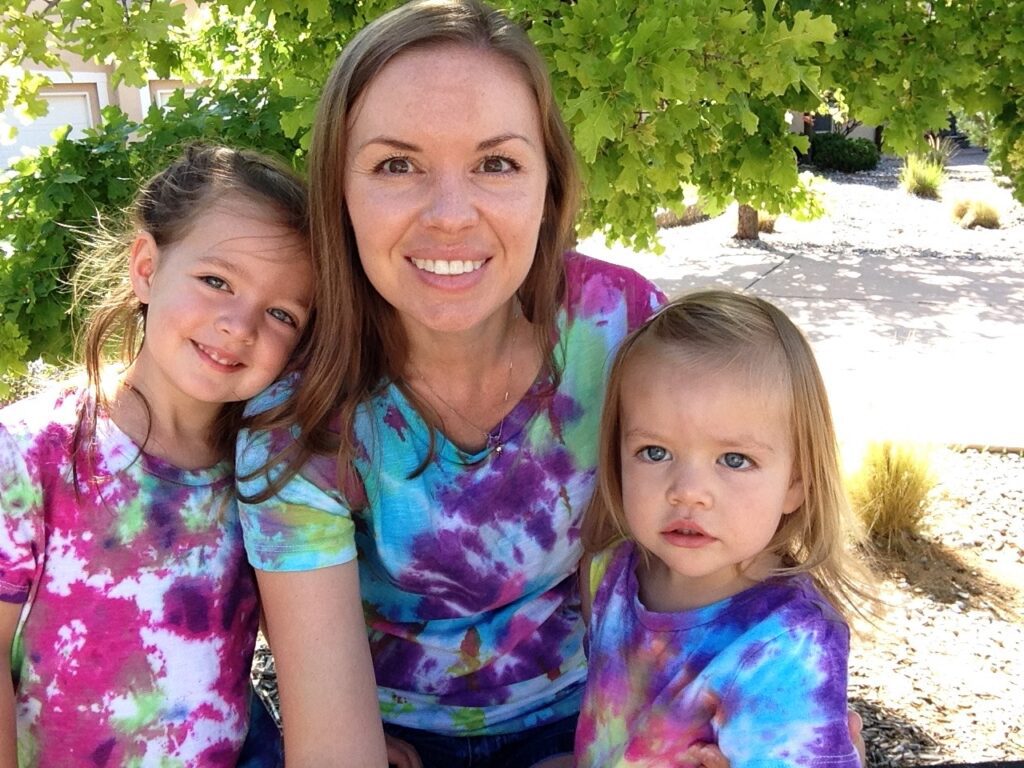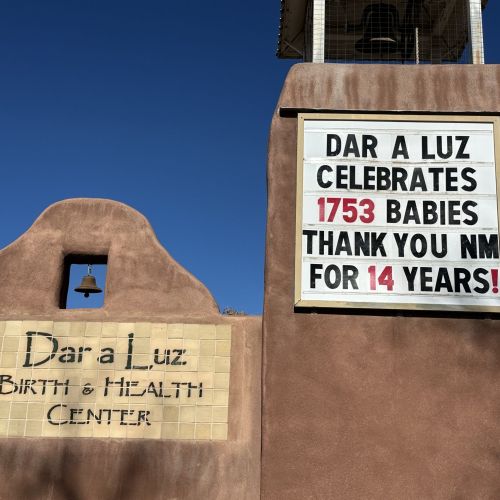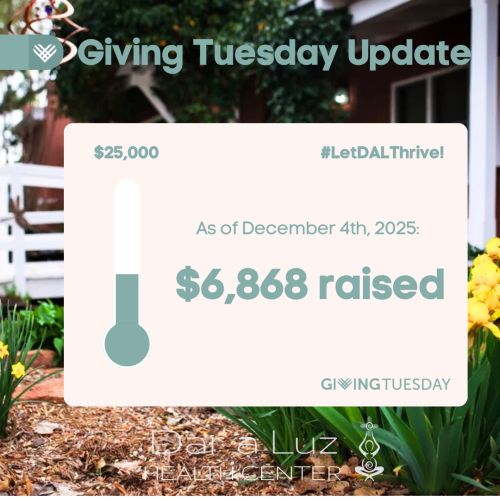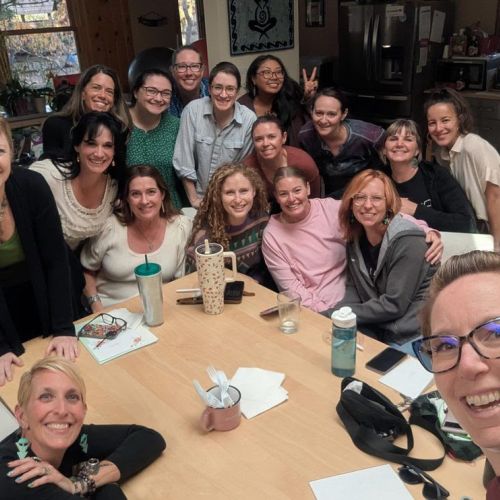The “Dirt” on Dirt
by Stephanie Sanchez RN, IBCLC
Did you wash your hands? Don’t track mud in the house! Did you use hand sanitizer? Don’t eat that off the floor! Don’t touch that, you don’t know where it’s been! Have those toys been wiped down? Get that out of your mouth! Did you wash your hands?!
If you’re a parent, chances are these phrases are on repeat for you too. Also, parent or not, you probably have big-time anxiety surrounding germs, given these past two years of life in a pandemic: using hand sanitizer EVERYWHERE and wiping down EVERYTHING. And while these important tools definitely have their places (such as health care facilities and crowded public spaces), your own home isn’t necessarily one of them! As we spring forward after another isolated winter, where the kids have likely spent a lot of time indoors, it’s time to start thinking about getting outside and PLAYING IN THE DIRT! That’s right, I said dirt — the dirtier the better, really. Or even better yet, some MUD!
Did you know that outside play in the dirt is actually a super important part of a child’s growth and development? It has many health benefits!
First off, our immune systems are set to be “programmed” right from birth. This is why it’s so important for babies to be skin-to-skin with their parents and not bathed for at least 24 hours after birth.
Fast forward several months, and now, that baby is crawling everywhere and getting into everything. And while you may still cringe every time they stick their dirty hands in their mouths, it’s actually really good for them. Whether it’s out in the backyard or inside on the kitchen floor, this routine exposure to harmless microorganisms in the environment, such as bacteria found in soil, is actually kicking the baby’s immune system into gear and making it more robust.
Now, I’m definitely NOT recommending you let your baby lick the floor at the grocery store (ewwww!). It’s not about exposing the immune system to all of the “bad germs” in order to make us tougher. It’s more about increasing our exposure to all of the “good germs” normally found in the environment around us. These good germs actually help regulate our immune system and suppress inappropriate inflammation.
The controversial “Hygiene Hypothesis”, which was first put forth in 1989, describes how as humans have moved away from life on a farm or as hunter-gatherers, and more toward life indoors in more sterilized environments. This lack of exposure to microorganisms commonly found in dirt may be leading to a subsequent rise in impaired immune function, as evidenced by soaring childhood cases of allergies, asthma, eczema, and autoimmune disorders. The theory is that these children, who have little exposure to an outside environment and its plethora of benign germs, have immune systems that become “hypersensitized.” All of their little immune system “soldiers” (known as neutrophils) become super grumpy as they cruise around the body without anything to do, with little exposure to foreign microorganisms. When they do come into contact with something foreign, even simple pollen, they then go absolutely crazy and become explosively inflammatory, causing an entire cascade of problems. The body has to know “normal,” in order to recognize the “not normal” threats. You may have heard someone say that farm kids grow up healthier than city kids, and one big part of that old adage may be due to this routine exposure to dirt.
There’s more evidence for exposure to good germs. “The Farm Effect” study, published in 2012, showed that Amish kids who live on farms have about a 50% reduction in cases of asthma, allergies, and gut-related disorders compared to kids who live in more sterile environments.
And while the positive effect on a growing immune system appears to be one of the biggest health benefits, exposure to germs found in soil has also been shown to result in lower levels of C-reactive protein, a biomarker for cardiovascular problems later in life. This means decreased risk for cardiovascular disease and stroke.
In addition, common Staphylococci bacteria found on our skin actually help to prevent inflammation, improving our skin’s ability to heal wounds and manage inflammatory skin conditions such as psoriasis. Overuse of antibacterial cleansers and wipes can wreak havoc on our skin’s healthy biome.
Other amazing benefits of actually playing in the dirt
You’ve surely heard the reports that our kids are currently suffering from depression, anxiety, and ADHD at increasing rates. And while this may be due to many factors (playing in the dirt is definitely not a substitute for required medications and treatments), the science shows that more time spent outside in dirt and nature definitely has a positive effect on our mood and our ability to focus. There have even been studies on a particular microbe commonly found in soil called Mycobacterium vaccae which has been found to stimulate production of serotonin (the “feel-good” hormone), making us feel more relaxed and happy, improving learning, and reducing anxious behaviors. Being outside also means you’re likely getting healthy doses of sunlight, which stimulates both Vitamin D and serotonin, as well as helping to regulate the production of melatonin, resulting in better sleep.
Okay, so my nerd-brain thinks this is all super cool, but the best part of getting dirty outside is the ADVENTURE! Besides just making a mess, it’s also such an important learning environment. Kids who play outside in nature tend to use more imaginative and creative play, and are unknowingly using problem-solving skills as they ask questions and make observations.
Kids can truly be anything they want to be outside with a little dirt and creativity!
They can be artists, sketching designs with a stick on a dirt canvas, or maybe they’ll even try sculpting incredible muddy masterpieces!
They can be builders and engineers, creating forts and castles of all shapes and sizes with more sticks and mud. They could even go big, creating an entire town with a river running through it!
They can be biologists, learning about the habitats of worms and other creatures that live in the dirt.
Fun tip: the next time it rains, send the kiddos out on a “worm rescue mission” to save all of the worms that may have been flooded out of their homes from certain doom by frying on the sidewalk when the sun returns!
Then there’s my kids’ personal fave, they can be chefs! Have some good old mud-pie competitions, making all sorts of confections that can be decorated as lavishly as they desire with nature treasures they scavenge for!
And finally my favorite type of dirt-play, they can be gardeners. Now’s the time to start thinking about soil prep for spring planting! Let them work the soil with their tools (or better yet bare hands) and choose what to plant, and see what happens! Since it’s still a bit early and chilly, try starting some seeds indoors: all you need are some cups, good soil, and a sunny window. And while this type of dirt play is a little more “controlled” and may be considered slightly more of a “chore” (I see those eye-rolling pre-teens), it really teaches them how giving the soil a little love can really give us back so much more than the bit of work we put in!
Come summer and fall, having a garden from which they can harvest fresh food and flowers will also give them another feel-good boost: research suggests that the brain actually releases dopamine when we harvest food from the garden, also known as a “harvest high.” This likely stems from our days as hunters and gatherers. This feeling can be similarly extracted by simply seeing and smelling fresh produce, which is why wandering through a farmer’s market always puts us in a happy mood!
So, as a parent who is equally nervous about keeping my kids safe from pathogens or “harmful” microbes AND wanting them to get all of the exposure they can to beneficial or “healthy” microbes, as with most anything else, I find it’s about balance. As a nurse AND parent, I definitely lean heavy toward the sanitize-everything-clean-freak side (our dear Tracy will concur as she frequently witnesses me running around the birth center wiping down often-touched surfaces like a crazy person), but I will also eat a cookie dropped outside without much thought. I will make my kids use hand sanitizer when I pick them up from school, but I don’t make them take off their shoes indoors. I love to get dirty, but I equally love getting clean again! I still wipe everything down in my own home, but I use homemade non-toxic cleaners.
And even though we do not all live on farms or large plots of land these days, there are still several things you can do to help create more of a “farm effect” for your own home environment. First off, STOP with the hard-core antibacterial soaps and heavy duty detergents! Your home is not a sterile surgical suite! Their overuse will kill the healthy microbes that live on us and in us, creating a welcome open door for antibiotic-resistant and harmful disease-causing bacteria to take over. Replacing these harmful cleaners with simple solutions of household cleaners made with vinegar or alcohol and some essential oils is a great step! On that same note (deep breaths here, parents), try to resist the urge to immediately scrub/wipe down your child the second they get dirty. If it’s just some of your good dirt from your yard, let them soak in it a bit! Have play clothes that are okay to get muddy and grass-stained, and let them just go for it!
At the end of a good dirty day of play, they’ll have done their job, and earned that scrub down in the bath! Another helpful step for so many reasons: aim to keep your family’s diet as whole and fresh as possible, limiting additives and sugar, and increasing organic seasonal fresh fruits and veggies.
Probably the biggest takeaway though: GET OUTSIDE and don’t be afraid to get a little (or a lot) DIRTY! We are so fortunate here in Albuquerque to have an amazing climate with lots to see and do outdoors! We have a mountain forest to the east (forest dirt is the yummiest!), an entire bosque wilderness with muddy riverbanks galore right smack in the middle, and the gorgeous yet dusty petroglyph desert trails to the west. It’s all right here! Explore with your family by going on walks or hikes, and take it up a notch by bringing a bucket and shovel along and planning some stops off the trail for some digging fun. One of our favorite activities is trekking down to the river to our top-secret sandy beach spot, where we can kick off our shoes and spend the afternoon with our toes in the mud, creating castles for our baby frog and insect friends, complete with moats full of river water! Make it fun for kiddos by setting a goal for the number of walks or hours you can spend outside. Have you heard of the global movement “1000 hours outside?” The goal is to match nature time with screen time, which for most kids is an estimated 1200 hours per year. Check out the site HERE for some great downloadable trackers you can use (they also have a great app you can download to your phone to track your progress).
Consider spicing things up by starting a leaf/rock/flower collection from your travels!
And as with any outdoor activity, definitely use caution. You shouldn’t let your littles play in just any dirt. For example, a public park could have soil containing glyphosphate (the active ingredient in Roundup), or possibly pieces of trash or broken glass around, not to mention dog poop and cigarette butts. So if this is questionable, even in your own backyard, I would recommend getting a few of the best bags of dirt that money can buy Find a way to create a safe dirt play area with good organic soil because they may eat it—and again, it’s okay) that is specifically for little babes to play in. Trust me, a patch of dirt that they can just play and explore in is far superior to any toy you can buy. Consider adding “bags of good dirt” to your little one’s next birthday or Santa wishlist.
So repeat the mantra after me, “DIRT IS MY FRIEND, DIRT IS MY FRIEND, DIRT IS MY FRIEND!” Hope you all have some good (dirty) fun outside soon!
PS–If you’re a microbiology nerd like me, you may also enjoy this read for more great info on this topic:

Stephanie is the Lead RN/Birth Assistant at Dar a Luz, as well as an International Board Certified Lactation Consultant. She has been with Dar a Luz since 2014, joining the team after experiencing Dar a Luz care for herself in 2013 (baby #147). When she’s not attending births or in the lactation clinic, she’s playing and exploring outside with her own daughters, probably in some good dirt, and looking forward to sunny summer days and a bountiful harvest from the garden ahead!



